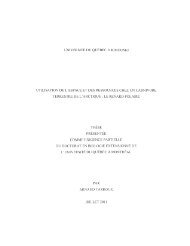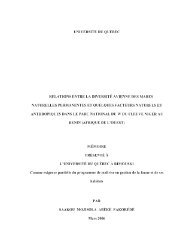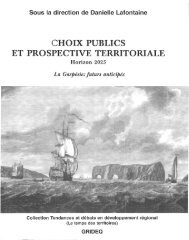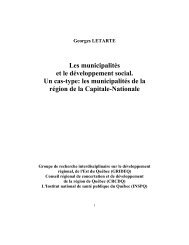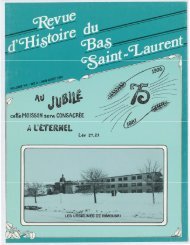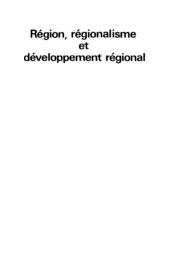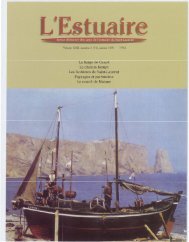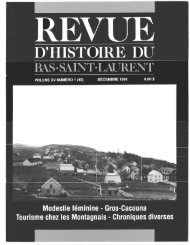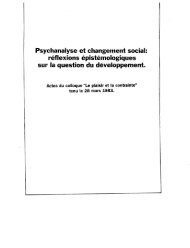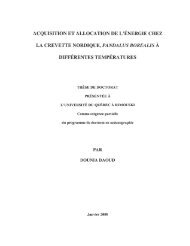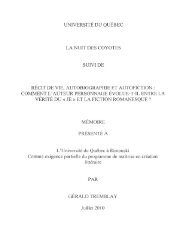influence du climat et de la prédation sur l'utilisation de l'habitat et la ...
influence du climat et de la prédation sur l'utilisation de l'habitat et la ...
influence du climat et de la prédation sur l'utilisation de l'habitat et la ...
You also want an ePaper? Increase the reach of your titles
YUMPU automatically turns print PDFs into web optimized ePapers that Google loves.
99<br />
juveniles. At the microhabitat scale, the type ofhiding site (<strong>de</strong>n, ground, or tree) and the<br />
amount of protective coyer significantly <strong>influence</strong>d sUl·vival (Table 5.5). For a given location,<br />
use of si tes with high protective coyer enhanced <strong>sur</strong>vival (a 10% increase in the mean<br />
protective coyer used was associated with a 66% <strong>de</strong>crease in <strong>de</strong>ath probability, Table 5.5).<br />
Also, when taking into account the protective coyer used, use of trees enhanced <strong>sur</strong>vival<br />
compared to use of ground locations (8% <strong>de</strong>crease in <strong>de</strong>ath probability, Table 5.5).<br />
At the local scale, use of sites with higher shmb coyer significantly increased <strong>sur</strong>vival<br />
(Table 5.5) when percentages oftree and herb coyer were taken into account. According to<br />
the hazard ratio, a 10% increase in mean shrub coyer used was associated with a 74%<br />
<strong>de</strong>crease in <strong>de</strong>ath probability. Also, when taking tree and shrub coyer into account, use of<br />
sites with higher herb coyer <strong>de</strong>creased <strong>sur</strong>vival (78% increase in <strong>de</strong>ath probability, Table 5.5)<br />
although this effect was not statistically significant. Finally we found no effect ofsex (X 2 1 =<br />
0.30, P = 0.586), mass on 10 June (li = 0.01, P = 0.915), mobility (X21 = 1.94, P = 0.163), or<br />
distance to the mother (li = 0.32, P = 0.570) on <strong>sur</strong>vival.<br />
Table 5.5 : Coefficients for the <strong>sur</strong>vival analyses for 14 juvenile North American porcupines<br />
studied in Parc National <strong>du</strong> Bic, Québec, May to August, 2003-2004<br />
Variable ê value SE<br />
j<br />
"t,.-<br />
P<br />
Hazard ratio<br />
M icrohabitat scale<br />
Protecti ve coyer - 1.072 0.478 5.03 0.025 0.34 ( 10%)<br />
Location<br />
Ground 0 ND ND ND reference category<br />
Den -0.026 0.030 0.75 0.388 0.97<br />
Tree -0.089 0.037 5.89 0.015 0.92<br />
Local scale<br />
Tree coyer -0.2 13 0.272 0.61 0.433 0.81 (10%)<br />
Shrub coyer -1.338 0.534 6.29 0.012 0.26 (10% )<br />
Herb coyer 0.579 0.312 3.44 0.064 1.78 (10%)<br />
5.5. Discussion<br />
Juvenile porcupines showed selection for high protective coyer at the microhabitat (1m)<br />
scale only. At the local (15 m) scale, juveniles selected sites characterized by a low herb<br />
coyer and with cedar as dominant tree species. The use of coyer <strong>de</strong>creased as juveniles grew



